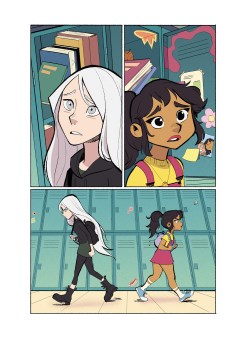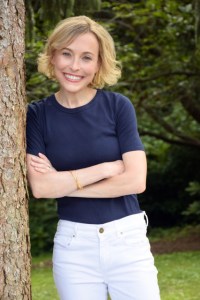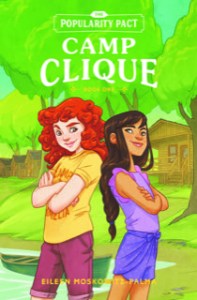 Welcome back, Mixed-Up Filers.
Welcome back, Mixed-Up Filers.
Today, we’re chatting with the creators of the newly released Anti-Hero from DC Comics, authors Kate Karyus Quinn and Demitria Lunetta and illustrator, Maca Gil. Thank you all for joining us today!
My first question is for all of you. Can you tell us a little bit about Anti-Hero?
Kate and Demitria: Anti/Hero is the story two 13-year-old girls. Sloane thinks she’s a villain and Piper very badly wants to be a superhero. The girls end up battling over the same stolen object, an experimental scientific device. When the device accidentally powers on, the girls switch bodies. Now Sloane and Piper must learn to work together – or risk destroying each other.
Maca: It’s also super sweet but packed with fun and crazy action involving chases, drones and giant mutant creatures. It’s pretty cool.
Another question for the group. Hummingbird and Gray are completely new characters in the DC Universe? What was the process of creating them like?
Kate and Demitria: It was amazing! To add new characters to the DC Universe is a “when lightning strikes” sort of opportunity. How often does it happen? And to be able to add two new amazing female characters is even better!
When creating them, though, we weren’t really thinking about them as DC characters. Instead, we wanted two create two multifaceted girls whose problems our readers could relate to and understand.
Maca: I think if I ever see anyone cosplaying Piper or Sloane my heart is going to melt off of my chest. This has been an amazing opportunity and I’m so happy I got to do it with this team.
Kate and Demitria, what was the process of co-writing like? Did you each choose a character’s point-of-view to write from?
Kate lives in Western New York and Demitria is in Wisconsin, so we wrote long distance, communicating via text, email, and the occasional phone call. In between all
that back and forth we wrote the script by constantly passing it back and forth. Kate would write a bit then send it to Demitria. Demitria would tweak what Kate wrote and add a bit more. Then back to Kate, to okay or change again what Demitria changed on her stuff, read what Demitria added, and then add a bit more. In the end, both are our fingerprints are on every single sentence.
Also for Kate and Demitria, there’s a lot of emphasis on family throughout the story. Was that something that you wanted to focus on early on? Or did it develop out of the body switching plotline?
We definitely wanted to focus on family, because it shaped so much of who the girls are and how they experience the world around them. Piper, despite her parents being absent, has a really strong and supportive family unit. Sloane, on the other hand, has a loving Mom, but because of work she isn’t around much. And Sloane’s grandfather…well, he’s definitely not the type of role-model you’d want a kid to have.

Maca, how did you come up with the costumes for each girl’s alter-ego?
Piper loves fashion and wearing crazy colors, she is strong and full of energy. The visual cues that represent her have to be dynamic and striking. Sloane, on the other hand, is a lot calmer and hates to stand out. Visually she has long vertical lines (her hair and her height help with this!) and she loves black. When I came into the project Kate and Demitria had written such rich and alive characters that designing them was a treat. They also get even cooler costume design as the story progresses; I can’t wait for you all to see.
Also for Maca, I saw (and loved) your Batgirl illustration on Burnside. Have you always been a DC comics fan? Are there any easter eggs that readers should keep an eye out for?
Thank you! Admittedly, I only started once I was out of college and a bit older, but so many women characters in the DC universe grew on me so much and so fast. Harley Quinn, Poison Ivy, Batgirl! There are so many amazing ones, and their designs and stories are so iconic. I would completely die for Piper and Sloane to have a crossover with some of them someday.
For Demitria and Kate, this is your first MG novel. How does writing for MG differ for writing for YA and adult audiences? Also, it’s your first graphic novel. So, how did that process differ?
Writing MG was so fun because we were allowed to really let our silly and playful sides let loose. Both of us tend to write YA with darker themes, so it was really fun to play in this world where even at their worst—things were a little lighter.
 Is there anything else about the story that any of you would like to share?
Is there anything else about the story that any of you would like to share?
Kate and Demitria: We had to come up with an MG safe expletive for Sloane to use and decided on Zooterkins. We would love to see it catch on!
Maca: So many pancakes get eaten throughout this story. I had to stand up and make some for myself a couple of times due to having to think about them so much.
(Honestly, same. I definitely made some pancakes after reading this.) What’s the best piece of creative advice that you’ve received that you’d like to pass on to other writers and artists?
Kate: Even when you want to quit—don’t. Just keep writing. Or creating whatever you create.
Demitria: Writers need to read! Anything you can get your grabby little hands on.
Maca: Copy and study your favorite artists, but do it properly! As long as you keep your inspiration sources diverse, your product will end up being uniquely yours because of your own sensibilities, strengths and limitations.
What is something that people would be surprised to learn about you?
Kate: I hate horror movies. They literally terrify me.
Demitria: I make no secret of my dorkiness, but sometimes it still surprises people.
Maca: I have played over 400 hours of Animal Crossing: New Leaf
Who is your favorite DC character (apart from the ones you’ve created)?
Kate: Wonder Woman!
Demitria: Batman!
MeetMaca: Batgirl of Burnside <3
What are you working on next?
Kate and Demitria: Hopefully more MG graphic novels!
Maca: I’m currently storyboarding for a feature film, but I can’t wait to do more comic books.
How can people follow you on social media?
Kate: I’m @KateKaryusQuinn on both Instagram and Twitter or you can visit my website www.KateKaryusQuinn.com
Demitria: I’m @DemitriaLunetta and my site is www.demitrialunetta.com
Maca: I’m @macagil on Instagram!
Thank you so much for the interview!
AntiHero is out now! Get your copy here or try your luck in our give-away!




 Eileen Moskowitz-Palma and I first crossed paths more than a decade ago, at the Backspace Writers Conference, in New York. I can’t remember which panels I attended, but one thing stands out: meeting Eileen. We were sitting in a large, well-lit room, waiting for the keynote to begin, when she turned around and smiled at me. It was the warmest, friendliest smile I had ever seen, and naturally I wanted to bask in her… Eileen-ness.
Eileen Moskowitz-Palma and I first crossed paths more than a decade ago, at the Backspace Writers Conference, in New York. I can’t remember which panels I attended, but one thing stands out: meeting Eileen. We were sitting in a large, well-lit room, waiting for the keynote to begin, when she turned around and smiled at me. It was the warmest, friendliest smile I had ever seen, and naturally I wanted to bask in her… Eileen-ness.
 MR: Camp Amelia is an adventure camp, with the focus on team spirit and athletic ability. There’s even a camp-wide sports competition (“the Cup”), where winning is everything. Were you sporty like Bea, or anxious like Maisy? Perhaps an amalgam of both?
MR: Camp Amelia is an adventure camp, with the focus on team spirit and athletic ability. There’s even a camp-wide sports competition (“the Cup”), where winning is everything. Were you sporty like Bea, or anxious like Maisy? Perhaps an amalgam of both?